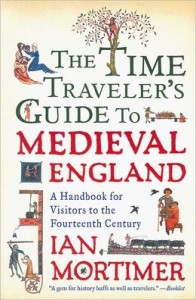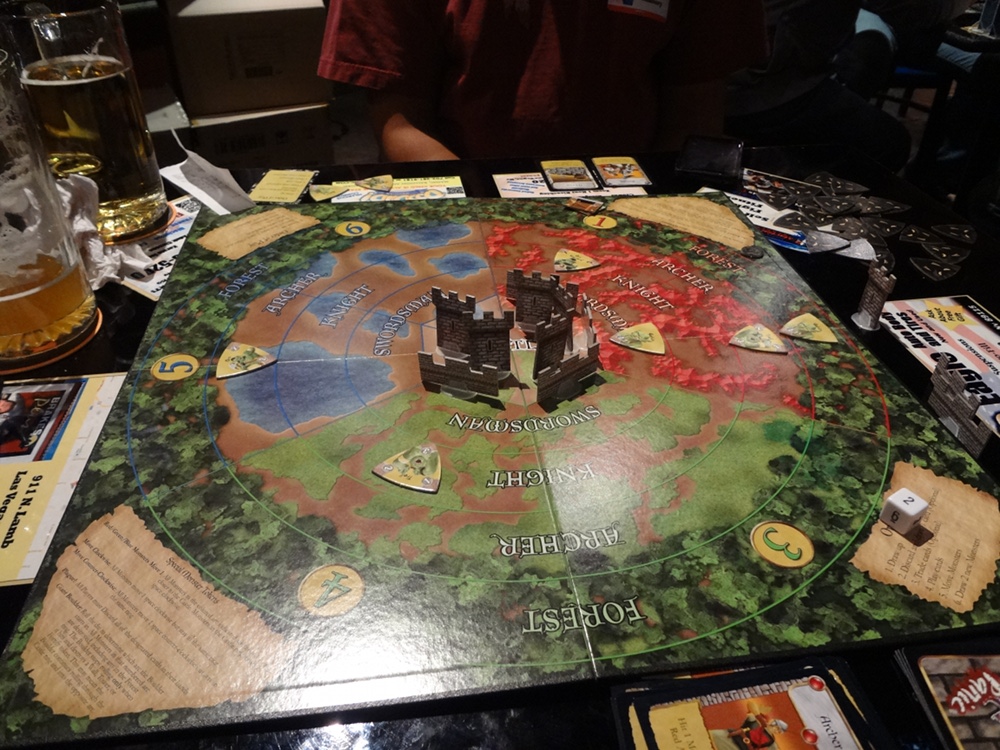The Time Traveller’s Guide to Medieval England by Ian Mortimer
 I’d like to think that I’ve gotten a lot out of my world travels, but in my visit to Japan, Shinto shrine blended into Shinto shrine. European castles vary, but only so much. Is one walled town so different from the next? Don’t get me started on Baroque and Rococo palaces. There is always a sense of place, but not necessarily of those who lived and died there. How did these people actually live? In The Time Traveller’s Guide to Medieval England, Ian Mortimer provides a captivating answer for the English living from 1300 to 1400. Mortimer writes of Geoffrey Chaucer, that “he can make the people come alive, with all their desires, fears, deceitfulness, lustfulness, and cheating.” But Mortimer’s description is just as apt for his own writing and because he does breathe life into 14th century England, I recommend his guide to any English teacher aiming for a better understanding of Chaucer, student of history, or fan of Braveheart, as well as to any tabletop gamer or LARPer.
I’d like to think that I’ve gotten a lot out of my world travels, but in my visit to Japan, Shinto shrine blended into Shinto shrine. European castles vary, but only so much. Is one walled town so different from the next? Don’t get me started on Baroque and Rococo palaces. There is always a sense of place, but not necessarily of those who lived and died there. How did these people actually live? In The Time Traveller’s Guide to Medieval England, Ian Mortimer provides a captivating answer for the English living from 1300 to 1400. Mortimer writes of Geoffrey Chaucer, that “he can make the people come alive, with all their desires, fears, deceitfulness, lustfulness, and cheating.” But Mortimer’s description is just as apt for his own writing and because he does breathe life into 14th century England, I recommend his guide to any English teacher aiming for a better understanding of Chaucer, student of history, or fan of Braveheart, as well as to any tabletop gamer or LARPer.
Beginning with his description of Shitbrook, the refuse-laden stream on the outskirts of Exeter, Mortimer unlocks the door to a treasure trove of medieval body functions. How one goes to the bathroom in a different place or time is really one of the most common questions we all have. In the case of medieval lords, Mortimer remarks, “wherever you go, a neat pile of wool or linen will be provided for you to “wipe your nether end.” Some great lords insist on cotton but it is not always available.” Life is different aboard a ship with Mortimer outlining diversions at sea, but he returns to the subject of relieving oneself and concludes that below decks on a ship, “Every storm has seen men and women emptying their stomachs, souls, and bowels down here in darkness and fear.” Occasionally Mortimer gets a little dry, such as when cataloguing merchants’ town house goods, but he gets juicy when describing surgeons, such as John of Alberne who pioneered surgical cleanliness as well as a method of “curing anal fistula, a nasty affliction following abscesses in the colon which particularly affects men who have spent too long riding in wet saddles…” Another medical highlight is provided in a quote from the physician John Mirfield on a remedy for tuberculosis: “take blind puppies, remove the viscera and cut off the extremities, then boil them in water, and bathe the patient in this water…” On the whole, Mortimer’s writing retains a conversational and informative flow with some occasional humor. In his chapter on medieval medicine he writes:
So, as long as you can get enough to eat, and can avoid all the various lethal infections, the dangers of childbirth, lead poisoning, and the extreme violence you should live a long time.
All you have to worry about are the doctors.
Role-Playing and Gaming Connections
Besides a brief mention of popular medieval games, Mortimer’s book has little to do directly with gaming itself. But since medieval Europe – England in particular – is the basis for most of Western fantasy, The Time Traveller’s Guide to Medieval England is a great study in improving the earthiness and sense of reality for role-playing games. Even within the first paragraph of Ian Mortimer’s introduction he poses questions familiar to any role-player after first setting the scene of a dusty London street:
The wooden beams of houses project out over the street. Painted signs above the doors show what is on sale in the shops beneath. Suddenly a thief grabs a merchant’s purse near the traders’ stalls, and the merchant runs after him, shouting. Everyone turns to watch. And you, in the middle of all this, where are you going to stay tonight? What are you wearing? What are you going to eat?
As for those medieval games and pastimes Mortimer details campball (football/soccer), tennis, archery, and wrestling. More intriguingly he categorizes cockfighting as an interest of boys and girls and describes cockbaiting as “throwing sticks and stones at a tethered chicken.” This is the child’s version of bearbaiting and bullbaiting, in which adults attack those animals with sticks and sic dogs on them. As for dice games, Mortimer states that they, “are are enormously popular”, which is also indicative of his present-tense style used throughout the guide to present the facts of medieval England to the reader as if he or she were really present. The last games described are board games including an early form of backgammon called tables, nine men’s morris, and checkers. Mortimer points out to his modern audience that the rules of chess differ between then and now with queens only moving one square and bishops moving only two squares at a time. These pieces were also known by different names, prime ministers and elephants respectively.
World Building for Fantasy Authors and GMs
Back in 1989 TSR released Cities of Mystery for Advanced Dungeons & Dragons, featuring several dozen card stock buildings and double-sided city street maps. The box also came with a great city guide written by Jean Rabe for GMs to design their own fantasy towns and cities. How did the town come to be? How has it grown? Who guards it? The Time Traveller’s Guide is a great compliment to Rabe’s hard work. Both cover much of the same ground, but in different veins with Rabe quantifying and randomizing a town’s dimensions and occupants in true D&D percentile fashion. Mortimer is much more personal and personable, putting a human face on many medieval problems. Rabe’s prohibition on the smellier occupations, like tanning, are best explained by Mortimer. His Borough Ordinances of Worcester list includes “The entrails of butchered beasts and pails of blood are not to be carried away by day but only by night.” and “No saddler, butcher, baker, or glover, nor any other person, may cast entrails, “filth of beasts’ dung”, or dust over Severn Bridge. Also no one may shave flesh, skins, or hides but above the bridge…” In our sanitized world it is easy to forget how leather gets created or how steak gets to the plate, but in medieval society neighbors affected by the processes of tanning and butchering had to deal with their side effects on a daily basis. That the medieval English were concerned about hygiene, sanitation, and cleanliness despite ignorance of germ theory is shown by their laws and ordinances. It’s also one of Mortimer’s few reoccurring themes: the similarities between past and present and withholding judgement on our ancestors. As he puts it, “Of course they are not all filthy. Many are proud of the clean state of their houses – like their modern counterparts – regardless of the judgments of people in six hundred years’ time.” After reading through Mortimer, a GM will probably question and improve on many of the basic realities of his fantasy setting. To put it more bluntly, he or she will have to decide where the high elves crap. Do prostitutes denote themselves with a special color (yellow hoods, in the case of the historical English)? Fantasy rules for peace-bound weapons abound, but what about gate and bridge tolls?
The Time Traveller’s Guide has a more specific use for GMs as well. Those dry tables of 14th century values collected from tax reports listing folding tables, brass pots, and basins are reminiscent of the equipment sections of any Player’s Handbook. While there are only a handful of weapons and armor priced out, Mortimer has the appraised values covering many other areas. A GM (or even a fantasy author) could compile the values in a spreadsheet and compare the prices to arrive at a ratio-based understanding of how a sword’s price (1-2 shillings) compares to a roast goose (7 pennies) compared to a packhorse’s price (5-10 shillings). Mortimer also details wages, inn stays, and quite importantly, fines. Don’t worry, the odd monetary system of the English is covered in Mortimer’s chapter on measurement so you can convert between pounds, shillings, pennies, and stranger denominations with a little effort. Keeping in mind the economic turmoil created by the Black Plague and many other factors, an industrious Game Master can create a table of ratios for use in any fantasy RPG with a setting like medieval England.
Food and Clothing: Medieval England for LARPs, the SCA, and Re-Enactors
While tabletop GMs will reward their players with close attention to Mortimer’s chapters on clothing and food, the two chapters are essential reading for Society of Creative Anachronism members and LARPers. Besides the costuming, most good SCA/LARP events feature food. Great events feature drink of the alcoholic variety! Throughout his guide, Mortimer presents information on the three estates of England, the peasantry, townsfolk and gentry, and the nobility. The nobility are further divided into the clergy and the secular, with occasional special mention of royalty. Just like your clothing or domicile, what you would eat or drink in 14th century England is based on your estate. Wine and spirits were limited to the well-off while the prices of ale and bread, as staples of townsfolk, were heavily regulated. Rural peasants made their own. Mortimer focuses a lot of attention on the rarity of meat, which was normally limited to four days a week due to church edicts, and the corresponding association of meat as a status symbol. While his descriptions might make a chef drool at the variety of spices and fruits on offer, what was actually included in the category of fish caught my attention. Besides whales, “seals, porpoises, dolphins, barnacle geese, puffins, and beavers are all classed as fish as their lives begin in the sea or in a river.” The prohibition on eating meat was taken quite seriously, Mortimer notes, so these sources of protein were “eaten gleefully” on the 194 or 195 days of the year when only fish were allowed.
Mortimer’s 19 pages on medieval clothing are the most engaging that I’ve read on the subject, having thumbed through a dozen or so costume books. Using the same structure of the three estates, Mortimer notes the contrasts between the dress of paupers, yeomen, and noblemen. More importantly, he lists the clothing regulations established by the Sumptuary Laws of 1363 which actually restricted the lowly-born from dressing above their station. Mortimer also traces the considerable changes in both men’s and women’s fashions in 14th century England. Ever wondered about those odd pointy shoes so similar to those worn by court jesters? Read The Time Traveller’s Guide to Medieval England and Mortimer will satisfy your curiosity and introduce you to the ridiculous twenty-inch Crackow, which was the footwear equivalent of a Humvee in its day.


